It’s the bunya nut, Australia’s tallest bush tucker!
Names
Once again we meet another ancient denizen of the shattered southern continent of Gondwana: genus Araucaria (A.). Named after the Arauco region of Chile where Spanish explorers first encountered these bizarre trees, there are now 19 identified living species of Araucaria globally, almost all exclusive to the southern hemisphere.
Mainland Australia is home to two of these species: the subject of this article, the highly esteemed bunya pine or bunya-bunya (Araucaria bidwillii); and the even more common hoop pine (A. cunninghamii), which also extends north into Papua New Guinea and parts of Indonesia and Malaysia, the only place in the northern hemisphere that an Araucaria occurs naturally. A third species occurs endemically off the continent, the Norfolk Island pine (A. heterophylla), but it was introduced early to the Australian mainland by fascinated botanists and silviculturalists keen to get their hands on its lengthy softwood planks. A fourth species, Cook’s pine (A. columnaris), originally from New Caledonia, has also been introduced to Australia as an ornamental and is easily confused with the Norfolk Island pine when young.
The international species of interest for overseas foragers include the two South American species: the endangered, cold- and altitude-resistant monkey puzzle tree, also known as Chilean pine or pehuén (A. araucana), whose edible seeds are called piñones. The second is the now critically-endangered Brazilian pine or pinheiro-do-paraná (A. angustifolia), whose former 233,000 ha. (90,000 sq. mi.) range throughout Brazil was utterly decimated after WWII to supply wood for rebuilding bombed Europe. It has a popular edible nut known in Brazil and Argentina as pinhão. Papua New Guinea is home to the tallest tree of this genus, the enormous, 50-90m (165-295 ft!) Klinki pine (A. hunsteinii).
New Caledonia is, rather surprisingly, the world’s chief Araucaria biodiversity hotspot, home to 14 of the 19 global species occupying every conceivable habitat zone on those islands. Some rare New Caledonian specimens occupy only a single, constrained habitat threatened by ever-expanding nickel mining efforts. The most prolific Caledonian species is Cook’s pine (A. columnaris), a common ornamental in Australia, Hawaii (especially on Lānaʻi) and across other Pacific islands where it has been introduced.
Habitat and Range
Bunya pines (A. bidwillii) in their extant habitat are resilient, long-lived, old-growth rainforest trees, preferring the well-watered climes of Australia’s central east coast. They are typically emergent trees, towering over and above the rest of the forest canopy, standing proudly in full sun, thus they tend to struggle in the shade or understory until a break in the canopy gives them an opportunity to reach their maximum potential. Generally, the Australian bunya pines are not quite as cold or altitude adapted as the subalpine-loving monkey puzzle tree (A. araucana) of the central Chilean Andes, but they are reasonably frost and altitude tolerant once established; healthy ornamental specimens exist as far south as Hobart, Tasmania, and as far north as Kew, England. Bunyas are moderately susceptible to drought and are thus absent from or struggle in the drier central and western regions of Australia with less than 750mm (29 in.) annual precipitation (Zimmer et al. 2015: 224-226).
Bunya seeds were once primarily spread by Australia’s several large parrot species, especially sulfur-crested and gang-gang cockatoos, but nowadays humans are their chief means of propagation. Bunyas are best grown from seed, directly sown at the site due to issues with root binding in potted-replanted specimens. Seeds take 3 months to 3 years (yes, years!) to germinate and some experiments have shown that the saplings tend to have a decent long-term survival rates (PERCENT; CITATION). They can be grown from cuttings, but the cutting must be taken from the terminal leader for it to grow erect; side branches, if successfully rooted, will eventually topple over under their own weight and thus should not be used for cuttings.
The Araucaria were once a major part of the ancient global landscape, having previously covered most of the planet in bygone eras, with fossil remains of the trees as far abroad as England, Canada, Japan, and China, in addition to the range of the remaining Australian, South American and New Caledonian species. At the time of European colonisation, the original range of the bunya pine (A. bidwillii) was the south-east corner of Queensland, roughly between Toowoomba, Dalby, Kingaroy, Gympie and along the Maroochy River, but especially the region of the Blackall Range west of Nambour to the Bunya Mountains, where there still remains a beloved population of these ancient giants, older than 600 years and some standing 60m (195ft.) in height (Heap, 1965: 3). The trees in this area were so highly esteemed by Queensland’s First Nations that they were protected by the decree NSW Colonial Secretary E. Deas Thompson in 1842 and by early Queensland explorer and “bunya country"“ protector, Andrew Petrie (Heap, 1965: 3-4). Those protections were short-lived, overthrown by the newly formed Queensland Government’s Unoccupied Crown Lands Occupation Act of 1860 (section 21, which permitted logging) and the increasing “dispersal” of the forest-dwelling First Nation peoples of south-east Queensland (Haebich, 2005: 27; Heap, 1965: 5).
After the decimation of the highly valued red cedar (Toona ciliata) by the late 19th century, colonial loggers turned their attention to the lengthy softwood planks supplied by the bunya and consequently ruined most of this population’s original range. Despite the Bunya Mountains, the home of the last of the wild Australian Araucaria trees, being declared a national park in 1908, logging of the bunya only finally ceased in 1961 (Haebich, 2005: 28). Two separate, untouched populations of bunya pine were subsequently found to exist in far north Queensland, one at Cannabullen Falls in the eastern Atherton Tablelands, and the other in the Carbine Tableland in Mt. Lewis National Park (Picone, 2013). These tropical bunyas are largely regarded to be relicts, populations isolated by monumental environmental changes when the formerly-prolific genus died out elsewhere across the world, as the fossilised bunya pollen in the Atherton Tablelands suggests (Picone, 2013). I think it equally plausible they may be the result of more recent inter-tribal seed trade given the social and cultural importance of aboriginal gatherings and ceremonies in “bunya country” prior to European colonisation, a fact which could be verified with reference to the First Nation oral history surrounding the north Queensland bunya groves.
Since the mid-19th century, bunyas have been a popular ornamental planting, both private and public, which has helpfully re-expanded their range down most of the east coast of Australia, having been planted in botanical gardens, public parks and thoroughfares for their unique appearance. In Sydney, NSW, several hundred bunya trees stand silent watch over the loved and lost in Rookwood Cemetery, as they also do in Toowong Cemetery in Brisbane’s west, with individual and grouped specimens exceeding 70-100 years old now found dotted throughout Australia’s main cities. The more common hoop pine (A. cunninghamii) was exuberantly planted across Australia’s coastal parklands, where they still occupy prime beachfront real estate, but that species will receive its own bush food article in due time.
While international and local plantings of the distinctive bunya have slowed since the turn of the 20th century, they can still be found as far abroad as Hobart, Tasmania; the Royal Botanic Gardens, Kew; Naples, Italy; Trinidad; Singapore; Cairo and Giza, Egypt; parts of equatorial Indonesia; the University of California; and the Sarasota Jungle Gardens in Florida, and many other places besides (Haebich, 2005: 29), a true testament to the resolute hardiness of the tree across a very wide range of climate zones.
Identification
Key Identifying Features
Distinctive dome- or egg-shaped canopy/silhouette when viewed from afar.
Typically a tall, 20-60 m (65-195 ft.) single trunk pine-like tree, 1-3 m (3-10 ft.) in width at the base of the trunk; trunk base resembles an “elephant’s foot.”
Bark of old, mature trees is rich to dark brown, gnarly and knobbly; young trees have a spiky trunk and branches.
Branches occur in successive whorls, approximately 0.5 to 1.5 m apart, of 5-12 branches protruding horizontally, with lower, older branches drooping down towards the ground and upper, newer branches pointing upwards towards the sky; branches are largely bare of leaves except at the tips.
Very dark green spiky leaves; abundance of brown spiky dead foliage underneath the tree.
Leaflets grow oppositely in a spiral (distichous and decussate); leaflets slightly tapered at the base.
Mature trees (15+ years old) exhibit brown pollen-bearing male cones in spring-summer (August-January).
Mature trees (15+ years old) exhibit female cones once every three years (not necessarily synchronised) at the top of their canopy; female cones somewhat resemble a football- or basketball-sized, dark green spiky pineapple, 3-10 kg (6.5-22 lbs.) in weight; the heavy cones drop to the ground when ripe.
Cones, when broken apart, are brown, woody and resinous inside with 50-100 scales, each scale containing 0-1 hard, 4-7 cm (2-3 in.) long seeds (“bunya nuts”).
Each viable seed has a hard, brown, woody outer shell; contains a whitish-yellow edible starchy kernel very similar in taste and texture to a pine nut, with a small undeveloped plant (cotelydon/embryo) in the centre of it.
Five key features of the bunya (A. bidwillii) make them easily identifiable for even a novice bush food forager. The first of these is, when attempting to locate bunya pines, look up! Mature bunyas, the kind capable of bearing cones at 15+ years old, will usually be some of the tallest trees in the area (especially for urban-planted trees), towering up to 50m (165+ ft.), but usually in the 20-40m (65-130 ft.) range. Their distinctive, dome- or egg-shaped canopy/silhouette is the easiest give-away of their location. I repeat: look for that tall, pine-like tree with the unique egg-shaped top. The tree will typically have a single, long, straight trunk, although twinned trunks, where two trunks split from a lower point, occur occasionally as well. Mature trees, the target of the astute bush food forager, are usually 1-2m thick at the base; ancient specimens such as those in the Bunya Mountains can grow up to 3 m at the base of the trunk and 60m (195 ft.) in height. The bark is a rich to dark brown, gnarled and knobbly with an interesting creviced, patchy texture.
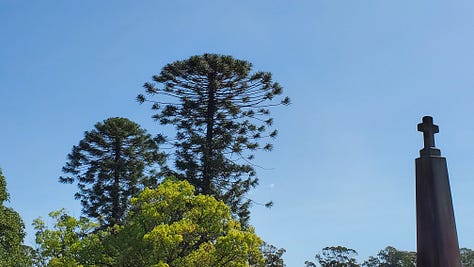

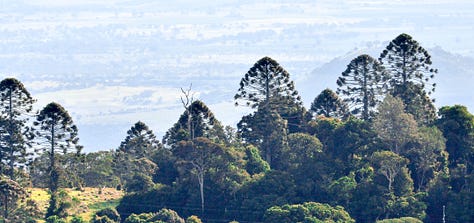
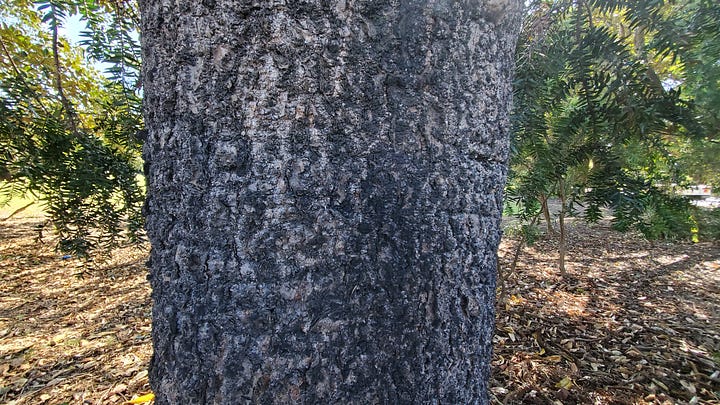
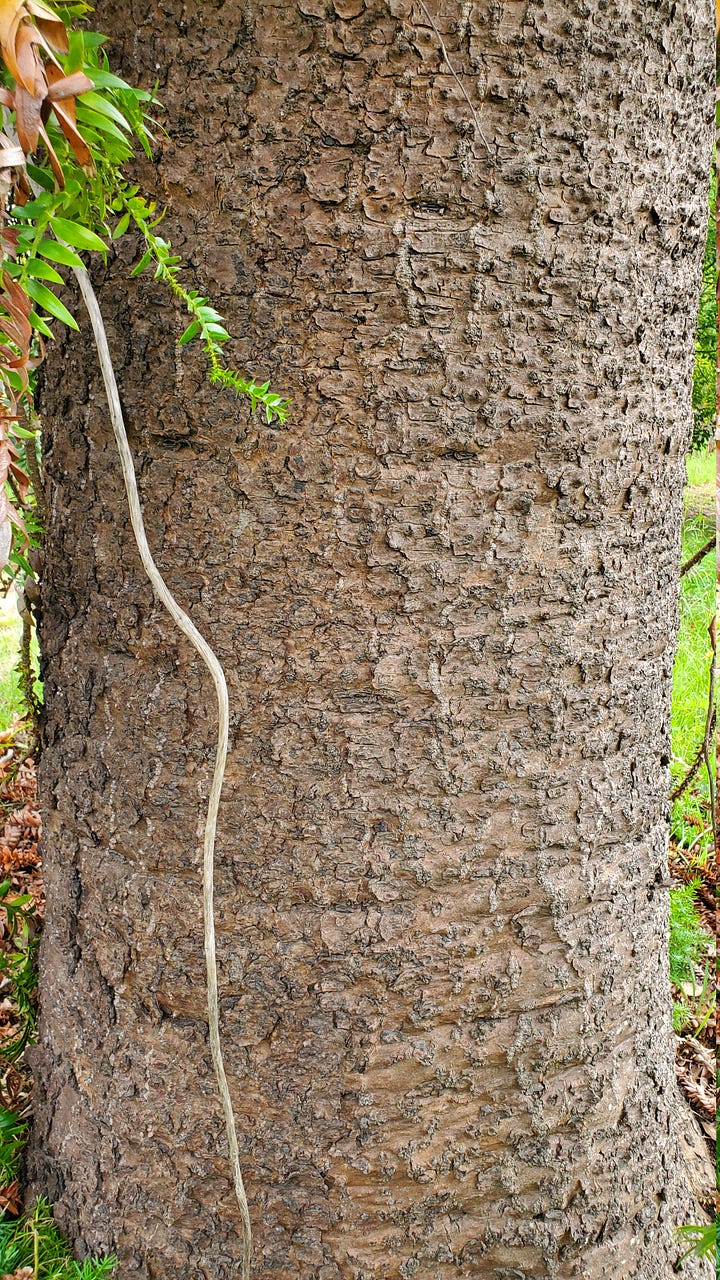

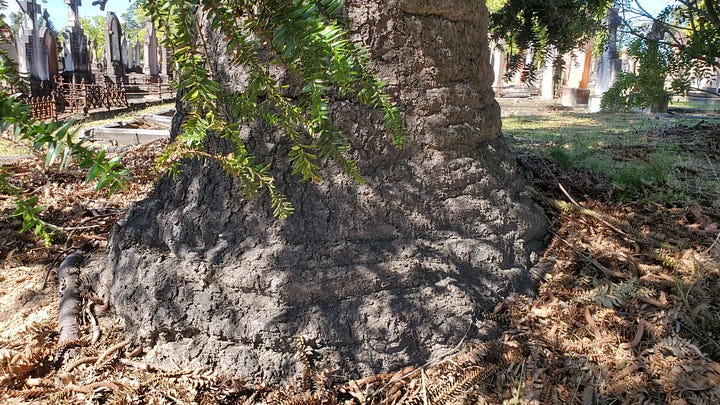
Their branching habits are the second key feature. Bunyas branch in successive whorls, usually 5-12 branches to a whorl. Older trees will often lose their lower branches; younger trees will retain them. Higher, newer branches point somewhat upwards, giving the ‘egg’ or ‘dome’ canopy its shape; branches in the middle of the tree typically point horizontally and lower, older branches will often droop down towards the ground under the weight of their terminal (end/tip) leaf clusters. Branches on young trees will be very spiky; older trees will tend to lose their branch spikes except in the very upper reaches of the tree and at the branch tips near the leaves.
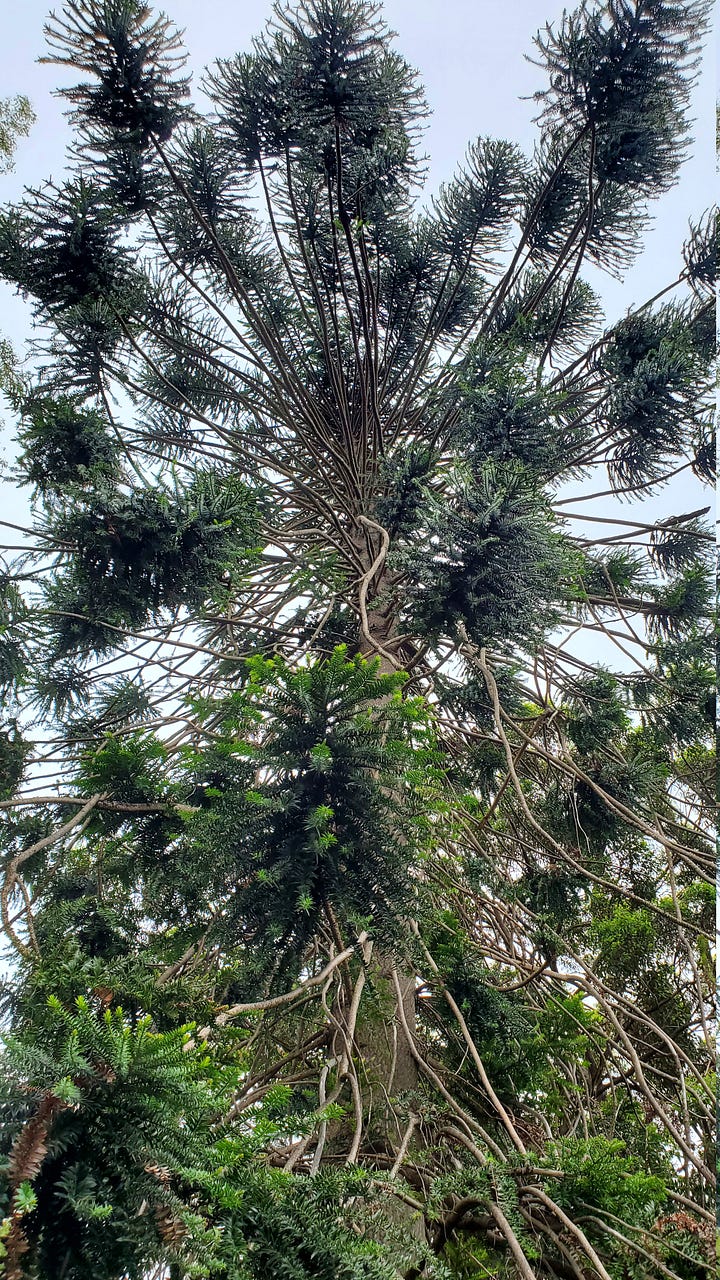

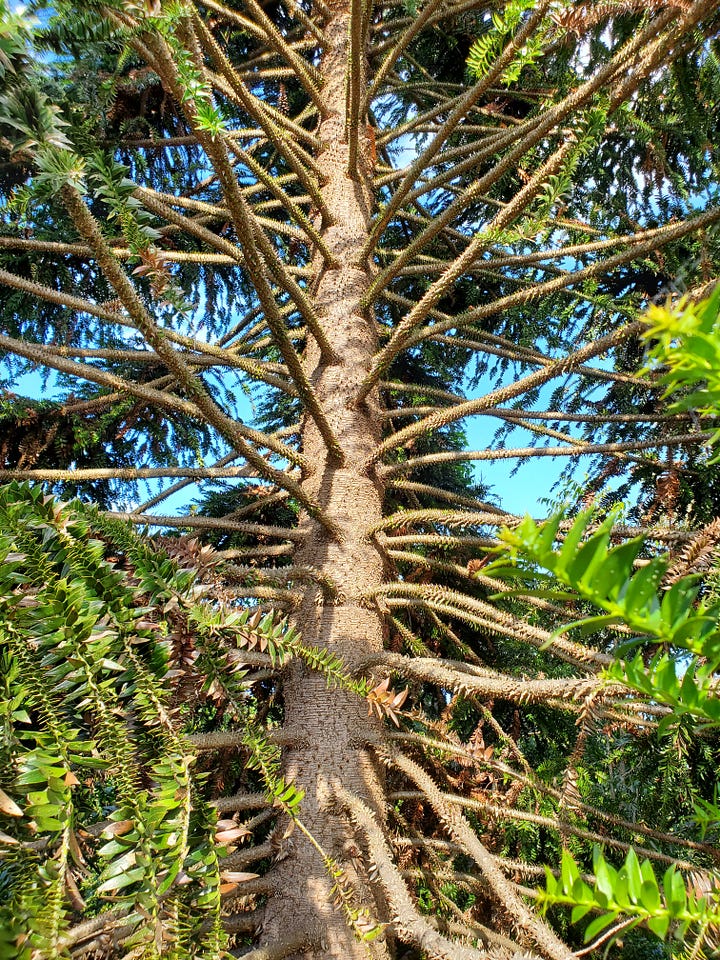
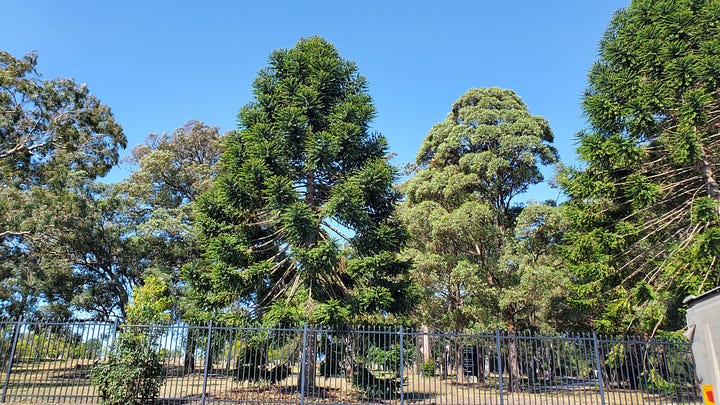
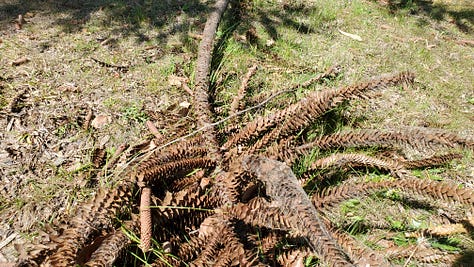
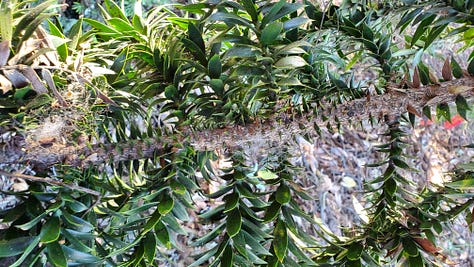
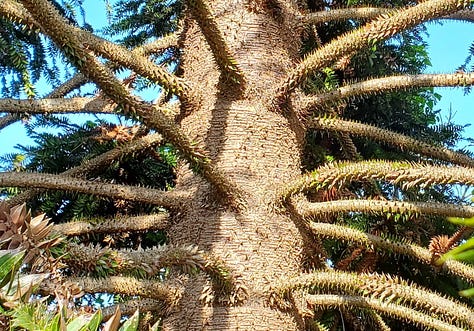
The third key feature is the foliage. Bunyas have largely terminal clumps of leaves at the end of the branches (see figs. 3, 4, 10, & 11 above), although younger trees may exhibit spiky leaflets along the length of an entire branch or even on the vertical trunk. Individual leaflets are sharp-tipped, triangular with a tapered base, stemless (sessile), growing oppositely. Each successive leaflet pair has a twist to the previous, thus making the whole leaf have a spiral appearance. The sharp leaflets are capable of easily piercing skin, even in their dry, fallen state, thus making them highly unsuitable for planting in public parks and thoroughfares without constant management of dropped foliage. Footwear and gloves are thus recommended when handling or walking amongst bunyas.
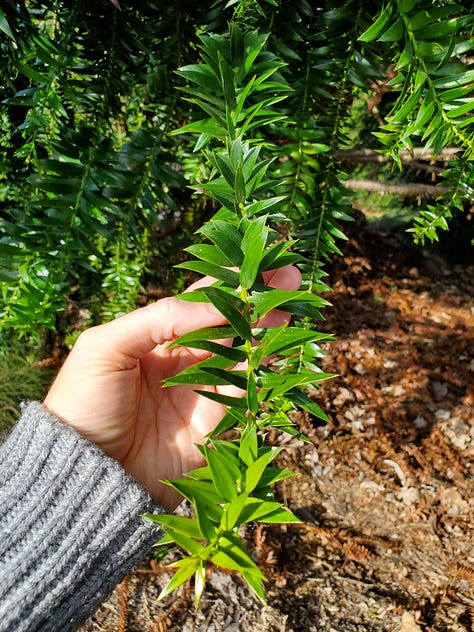
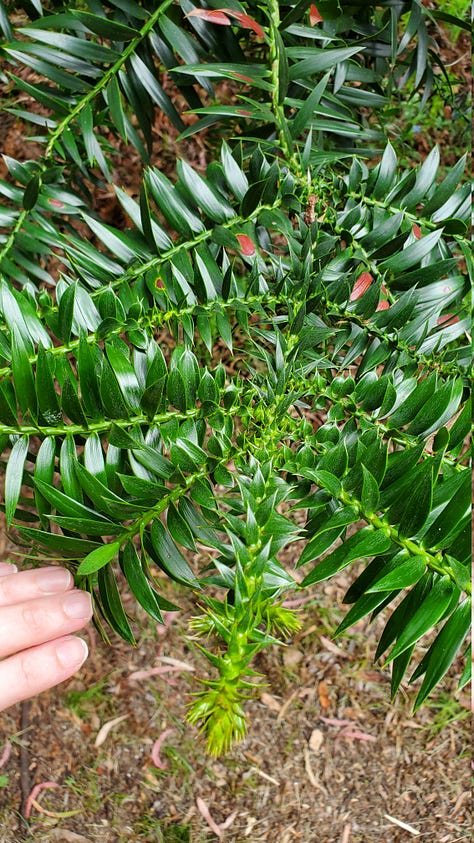


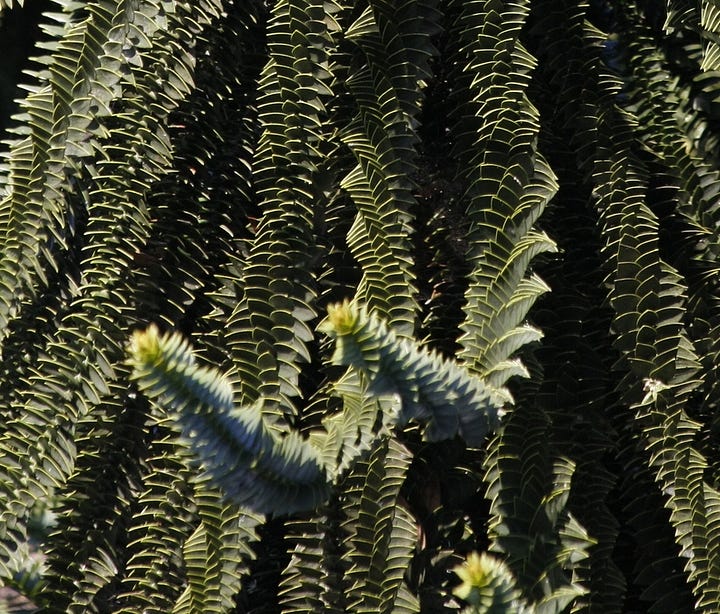
Bunya pines can have either distinct male and female trees (monoecius) or male and female parts on the same tree (diecious), usually the latter. As such, the fourth feature is the small, thin brown cones, 10-15 cm long and 2 cm thick, exhibited by male and bisexual bunyas in August-November (April-March in northern hemisphere), usually in the middle and lower portions of the tree. The cones release pollen directly into the air and it is moderately to severely irritating (Ogden, 2000: 41-42; rating of 8/10 on his allergy scale). The male cones have no culinary value but are essential for production of the viable nuts in the female cones. Monoeicious trees are capable of self-pollination, but the more trees that are in an area the higher the viable seed production will be on the female trees.



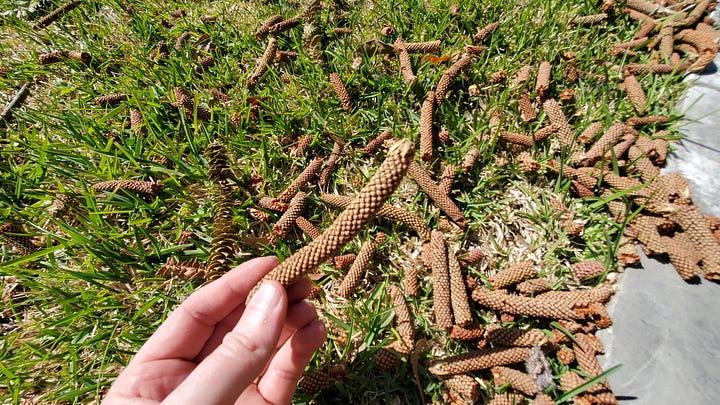
The fifth and most important feature, the chief object of culinary interest to the bush food forager, are the enormous, 3-10 kg (6-22 lbs), spiky, green, pineapple-like female cones, rivaled in size among the conifers only by the unrelated Californian Coulter pine (Pinus coulteri). The cones usually grow very high in the crown of the tree and thus well out of reach of all but the most agile, tree-climbing forager; it was one of the jobs for First Nations men of south-east Queensland to ascend a bunya’s crown and dislodge any remaining cones purposefully for harvest. Fortunately for 21st century foragers who may be significantly less adroit than aboriginal foragers of yesteryear, female cones will crash violently to the ground when ripe or dislodged by hungry migrating sulphur-crested, black or gang-gang cockatoos, usually between January-March (June-August in the northern hemisphere, minus the cockatoos!). Each cone consists of 50-100 spirally-arranged scales, with each scale bearing 0-1 seeds each. Some or many the scales will be empty, depending on pollination success, or else contain deformed, small or empty nuts. Better seed-to-scale ratios exist where copses of bunya trees grow together and female cones are more fully pollinated. The seeds, once removed from the scale, are 5-7 cm (2-3 in.) in length with a tough, brown, woody outer shell which requires peeling to reveal the edible, white, starchy kernel.

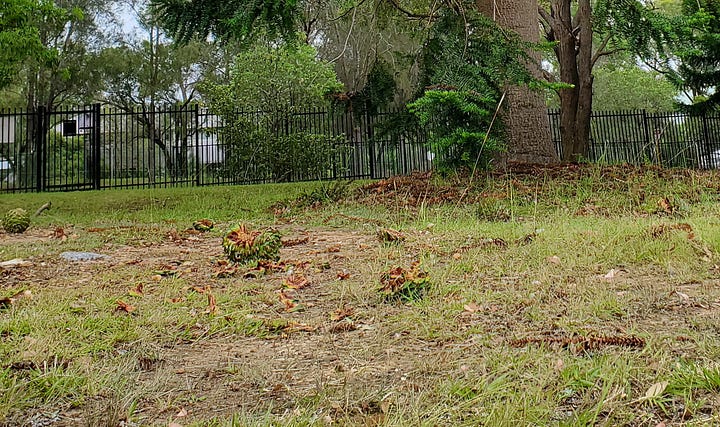
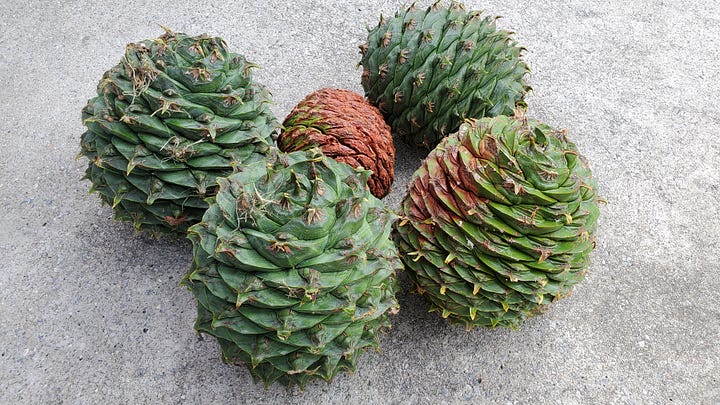
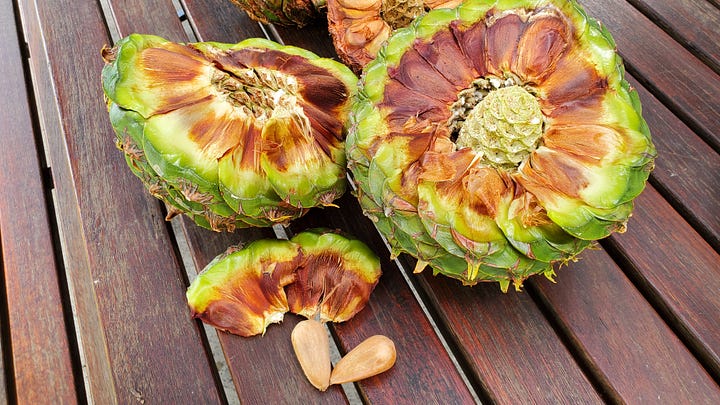
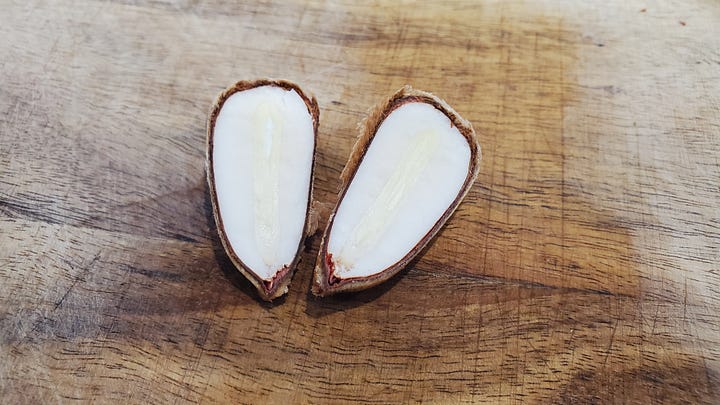
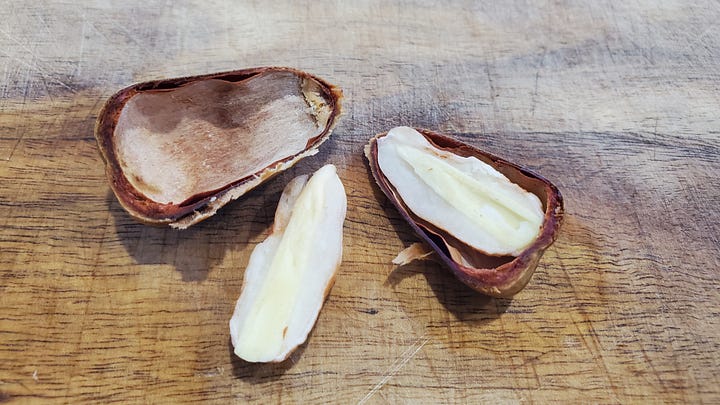
Culinary Uses
Bunya nuts vary in quantity by season and location. Given that the cones take some 18 months to fully develop, female parts of the trees will only have cones once in a three-year cycle, although these three year cycles are not 100% synchronised among all the bunyas in a given area. Thus, it may be a fruiting year for specific trees in a local region while others are barren, and yet others are forming juvenile cones to be harvested the next year. The observant bush food forager should note which trees are dropping cones in a particular year, and return to those specific trees in their 3-year fruiting cycle. For example, a lone bunya near my workplace in Burwood, Sydney, dropped about a dozen 4.5 kg cones in January 2024. This same tree was covered in male cones in September-November 2024, and will not have female cones again until January 2027.
Extracting bunya nuts from the cones is not as daunting as it looks. My advice is to leave collected cones to dry out for a week or two in a sunny spot sheltered from moisture, especially if your cones are dripping with fresh, sticky white bunya resin (sap). Drying out the cones prior to attempting processing will make them so much easier to break open (see fig. 29 above).
Once you can break your cones open freely with your hands (yes, drying them out enough will allow this, or if you just cannot quite get it open you can pry them that last bit with a screwdriver, chisel, axe, crowbar or claw hammer), separate each scale from the core and push the seed out starting at the tip. I did this task outside on a park table with a wheelie bin to toss the scales into (I live in an apartment), but gardeners may prefer to burn the pile of scales for use as biochar/ash fertiliser (remember that bunyas have spent some 18 months accumulating materials to construct their cones; those accumulated minerals make excellent fertiliser ash when returned to your garden).


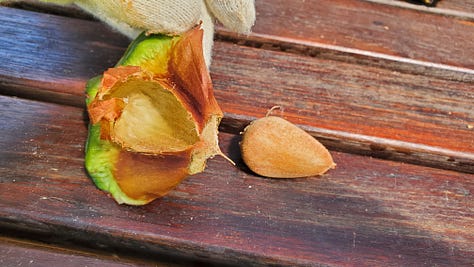
It took my wife and me approximately 30 minutes to process the scales of 8 cones weighing between 3 and 4.5 kg each. My observations with seed yields resulted in an average of 30% w/w seed yield per cone (30 kg of cones = 9 kg of unshelled nuts), although pollination of the female cones is certainly a major factor in seed quantity. My mother harvested a large cone near her home in SEQ and got less than a dozen viable seeds from the whole thing! Some folks like to “float test” the nuts after extraction from the scales; bad, old or non-viable (empty, though they have a shell) nuts will always float, whereas nuts with a wholly intact starchy kernel will sink.

Bunya nuts can be enjoyed raw, roasted and boiled, as well as being processed into a high starch, zero gluten flour. Raw, they are somewhat grainy in texture with faint notes of coconut, chestnut and sweet potato, but overall fairly bland; the cotyldon (undeveloped seedling) in the centre of the nut can have a faintly resinous or pine-like flavour. Roasting advice is varied, from 120°C for 45 minutes to 180°C for 15-25 minutes, or on hot coals until the hard brown husks char, but I personally think roasting draws out the best of bunya’s pine-nut flavours at the expense of drying them out; roasted bunya nuts are golden and delicious. Roasted bunyas can explode while roasting, so one ought to slice deeply, but not completely, through the hard outer shell before placing them on a tray in the oven. Flame or coal roasting causes the shells to char and become brittle, making them able to peel with the hands. Boiling advice also varies, from 15-45 minutes in a pot, although Naldony et al (2022) advised bringing the water to a boil, lowering to a rolling simmer, then boiling the nuts for 45 mins. Boiling bunya nuts will cause the water in which they are boiled to become a rich red colour, packed with antioxidant phenolic compounds from the hard shells, so do not throw it away as it can be drunk as a tea (see further under “Medicinal Uses” below)!
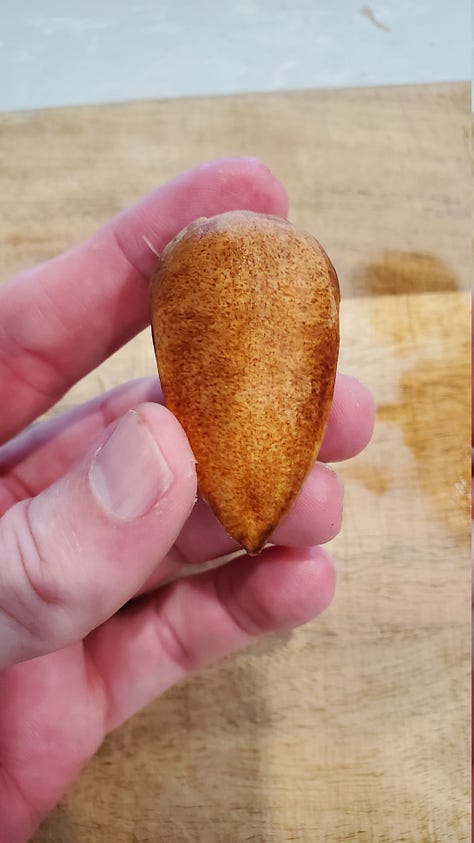
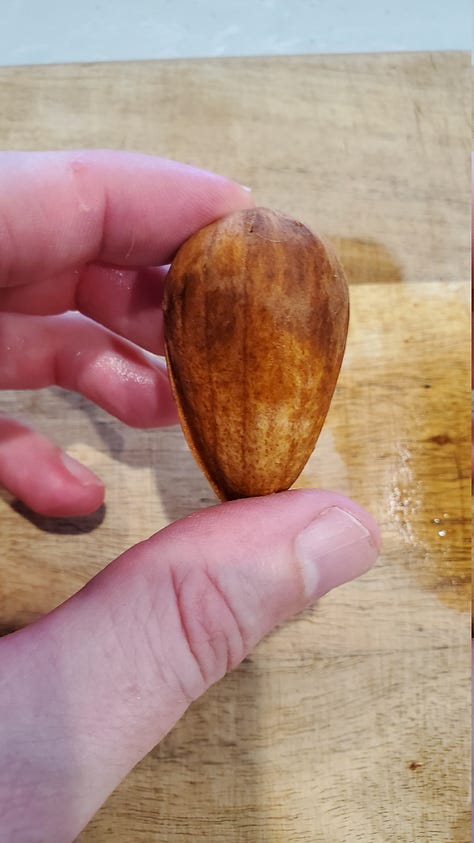
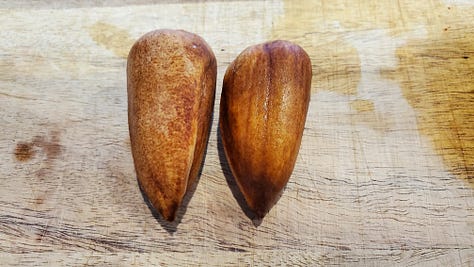
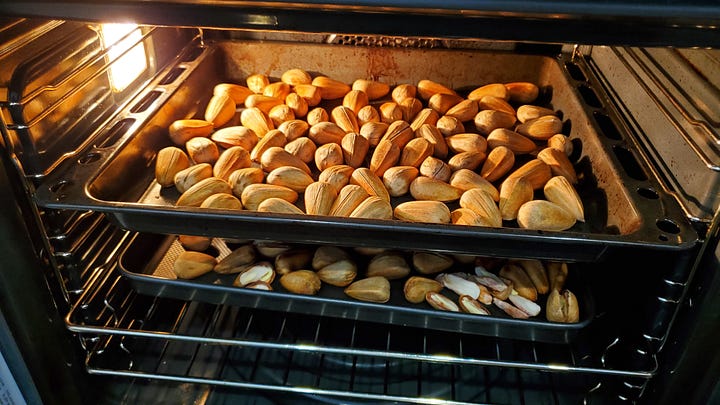

Naldony et al. (2022) did a detailed sensory study of cooked bunya nuts (when compared to chestnuts) and their culinary profile was professionally described as follows:
Bunya nuts are hard at first bite, slightly less hard than Brazil nuts and, during mastication, they may feel crumbly and grainy, similarly to macadamias, although dry, possibly because of its high starch content. They have a savory aroma and flavor, similar to cooked potato, as well as a roasted aroma, similar to toasted nuts and popcorn. Bunya nuts may taste and smell slightly sweet and develop sweet linger when swallowed. Some nuts can show a combination of slightly chemical, herbal (a combination of parsley and eucalyptus), and earthy (as root vegetables) aroma and flavors, ending with an earthy aftertaste. They are slightly hard to clear and leave a drying and numbing, almost metallic, sensation after swallowing.
Recent and thorough nutritional testing has proven the rightful exuberance at which the aborigines of south-east Queensland esteemed the bunya nut: they are true powerhouses of nutrition (Nadolny et al., 2022; Naldony et al., 2023). Preparation method does slightly impact nutritional profiles of the nuts as follows (Naldony et al., 2022):
Boiled (g/100g): dry matter 44.7; moisture 55.3.
Boiled dry matter: protein 4.2; fat 1.3; ash 2.3; fibre 7.6; starch 65.8; glucose 0.4; sucrose 4.2; fructose 0.6.
Roasted (g/100g): dry matter 60.4; moisture 39.6.
Roasted dry matter: protein 4.4; fat 2.7; ash 2.4; fibre 7.5; starch 65.4; glucose 0.4; sucrose 5.2; fructose 0.5.
Naldony' et al. (2023) is the most detailed study to date of the bunya nut’s nutritional and chemical profile, there compared with the remarkably similar South American piñones (A. araucana) and pinhão (A. angustifolia), sadly hidden behind a US$36 paywall. From what is freely available, they remark that bunya nut consists largely of a low-GI, complex carbohydrate; its protein profile is of “high quality, since it contains all the essential amino acids in high quantities;” the nuts contain valuable trace minerals like potassium, magnesium, iron, phosphorous, manganese and copper (compare the nutritional analysis of pinhão by Silva et al., 2022); and most of the fat content was polyunsaturated linoleic acid. It is no wonder the nuts were so highly esteemed by the aborigines of south-east Queensland!
An older source gave bunya nut nutrition per 100g as follows (Low, 1989: 220-221): 906 kJ energy; 42.7g water; 9.1g protein; 1.9g fat; 42.6g carbohydrates; 2.6g fibre; 9 mg sodium; 194 mg potassium; 62 mg magnesium; 7 mg calcium; 4 mg iron.
As I discovered in 2024, bunya nuts, removed from their scales but left in their hard, outer shell, do not store well at room temperature except as an entirely unprocessed whole cone; their moisture content makes them prone to mould even when stored in a cool, dark, draft-free place. They can, however, be frozen after cooking; this is best done by boiling whole unpeeled nuts and freezing them immediately while they are still hot (personal communication with Ross Rapmund, 2024) in which case they will keep, frozen, for several years in a delectable condition. I have personally frozen roasted (shelled) bunya nuts which also kept very well for the 8 or so months it took me to eat them all in 2024.
Bunya nuts can be an excellent substitute for pine nuts in any dish, including pesto (this is typically how the Australian Italian community utilises bunya nut). I was particularly fond of my wife’s manner of preparing them in a soy sauce stock together with pork (Korean bossam-style pork), and they would go very well as a replacement for potatoes or other starchy vegetables in soups, stews, casseroles, indeed, any dish where they can absorb the flavours of a rich sauce.
I have seen no advice on the preparation of bunya nut flour, but it would probably be a similar process to making pinhão flour as described by Zortéa-Guidolin et al. (2017):
The seeds were dehulled, dried in an MA 035 air-oven (Marconi, Piracicaba, Brazil) at 40°C for 48 h, and ground in a LM3600 disc mill (DM; Perten Instruments AB, Hägersten, Sweden) to a particle size range of 0.18 to 1.4 mm (pinhão flour).
Another source gave the method of producing piñones (A. araucana) flour by roasting the shelled kernels at 150°C for 24 hrs, and 150°C for 72 hrs to make piñón coffee (Gallia et al., 2020). These methods would very likely work for bunya nuts with little modification and create a niche market for bunya nut flour and coffee.
Some sources mention that aborigines of south-east Queensland, the homeland of the bunya, would bury fresh bunya nuts for several weeks or months in mud near creeks, returning later to eat the fermented, semi-sprouted nuts, including the taproots, of the yet-to-emerge seedlings (the taproot will deplete much of the starch in the seed). I have not yet attempted to replicate this culinary usage of the nuts.
Medicinal Uses
Far more medicinal attention has been given to the South American Araucaria, monkey puzzle (A. araucana) and Brazilian pine (A. angustifolia), but, fortunately, Australian Araucaria are reasonably close botanically, being packed with many of the same secondary metabolites, as well as many of the same resinous mono-, di- and sesquiterpenes as their South American cousins. The most detailed overall phytochemical and ethnopharmacological review for the whole family (including Wollemi and Agathis) is by Frezza et al. (2020) and worth reading in full for anyone who wants an overview of the trees general medicinal properties. An earlier review has useful phytochemical, ethnopharmacological and bibliographical sections but its distribution section is punctuated by a significant number of major errors (Aslam et al., 2013). In the abstract Aslam et al. stated that Araucaria “is indigenous to North America,” which is plainly false; Araucaria bidwillii should have its native distribution marked as Australia only; Araucaria heterophylla should have its native distribution marked as Norfolk Island only; they include Araucaria excelsa alongside its identical synonym, Araucaria heterophylla; same for Araucaria angustifolia/brasiliana, etc.
One interesting Iranian study discovered that bunya leaf (A. bidwillii) ethanolic extracts, administered at a rate of 300 mg/kg, showed anti-inflammatory effects on edema in rats on par with 5 mg/kg of the drug indomethacin (Ahamad et al., 2005). At the same rate of 300 mg/kg, the same bunya leaf ethanolic extracts exhibited significant antinociceptive (painkilling) properties in rats exposed to hot plates, approximately on par with acetyl salicylic acid (aspirin) administered at 100 mg/kg. Bunya leaf extract at 300 mg/kg performed better than aspirin (100 mg/kg) at reducing abdominal writhing in an acetic acid test in rats. This particular study thus somewhat justified the human ethnopharmacological use of bunya leaf extracts for these exact conditions (inflammation, swelling, pain relief), although it lacked human in vivo experimental proof of the medicinal properties of the bunya leaf ethanolic extracts.
In traditional western herbal medicine, bark resin of hoop pine (A. cunninghamii) was dissolved, quantity unspecified, into alcohol and administered at a rate of 20-30 drops, diluted further in water, to treat urine retention and kidney disorders (Lassak & McCarthy, 2011: 196). Its effectiveness in that task lacks further scientific clarity.
Once source remarked on the traditional uses of Brazilian pine (A. angustifolia):
“Different parts of Araucaria angustifolia tree are employed in Brazilian folk medicine. Tinctures of nodes are traditionally used orally or topically for the treatment of rheumatism. Infusions of nodes are used orally to treat renal and sexually transmitted diseases. Infusions of barks are used topically to treat muscle strains and varices. The syrup produced with the resin is used for the treatment of respiratory tract infections. Infusions of leaves are used to treat scrofula, fatigue, and anaemia. Tinctures of leaves are used to dried skin, wounds and shingles. “ (Freitas et al. 2009: 513)
Essential oil extracts (oleoresins) from bunya and Norfolk Island pine bark resin have demonstrated grastroprotective, anti-inflammatory and antioxidant properties useful for treating gastric ulcers, with bunya resin proving superior to Norfolk Island pine (Ali et al., 2022). According to this Egyptian study, resin of these two species consists of 71-73% monoterpene hydrocarbons. More specifically, Norfolk pine resin (A. heterophylla) contained 37 distinct compounds, primarily consisting of 57.79% α-pinene, 5.4% caryophyllene, 4.82% D-limonene, 4.65% trans-3-caren-2-ol, and other smaller quantities of camphene, sabinene and α-copaene. Another study of Norfolk pine (A. heterophylla) found only 32.93% monoterpene hydrocarbons in the bark resin. The main monoterpenes were sabinene (12.07%), D-limonene (11.22%) and β-pinene (6.44%). Sesquiterpenes included Caryophyllene (10.36%) and α-copaene (8.00%); the differences in compound perrcentages was noted and explained by way of extraction techniques, solvents, standard temperatures at time of testing, and significant differences in plant provenance (Soliman, Sabry & Abdelwahab, 2023).
According to the aforementioned Ali et al. (2022) study, bunya resin (A. bidwillii) consisted of some 17 compounds, primarily 63.4% α-pinene, 5.21% nonane and 4.37% trans-3-caren-2-ol, with trace quantities of D-limonene and 2,4(10)-thujadiene. That study also noted that bunya (A. bidwillii) foliage essential oils are significantly different to the trunk resin, with leaf essential oils consisting of beyerene (35.65%), transnerolidol (13.66%) and γ-elemene (6.09%). Ali et al. hypothesised that bunya and Norfolk pine bark resin modulates ROS/NF-κB/inflammatory cytokines as well as increasing Ki-67 expression, thus promoting healing processes in the stomach, although he importantly cautions for the need for further clinical trials of bunya resin extracts for peptic ulcers.
An earlier study compared 10 Araucaria species’ leaf extracts to compare them with the then-recently discovered Wollemi pine (Wollemia nobilis; Brophy et al., 2000). This analysis found the following components in leaf steam extracts for the primary Australian species. Bunya pine (A. bidwillii) leaf extracts consisted of mostly diterpene compounds, particularly hibaene (76%) and 16-kaurene (1.7%); the major monoterpene was a-pinene (0.5%); sesquiterpenes were primarily spathulenol (3.2%). Hoop pine leaf essential oils (A. cunninghamii) consisted of mostly diterpenes: hibaene (29.3%) and 16-kaurene (53%); monoterpenes were α-pinene (1.8%) and β-pinene (1.4%); sesquiterpenes were β-carryophyllene (5.5%), bicyclogermacrene (0.7%) and humulene (0.5%). Norfolk pine (A. heterophylla) leaf extracts were unique, consisting primarily of monoterpenes: α-pinene (52.4%), limonene (1.8%), sabinene (0.7%) and γ-terpinene (0.7%); sesquiterpenes were α β-carryophyllene (3.1%) and germacrene-D (1.9%); the major diterpenes were phyllocladene (32.2%) and 16-kaurene (0.6%). Cook’s pine leaf essential oil was devoid of monoterpenes, consisting of diterpenes B (32.5%), hibaene (9.4%), sclarene (5.7%), E (10.3%), 13-epi-dolabradiene (23.3%) and 16-kaurene (2.22%); sesquiterpenes were primarily δ-cadinene (0.8%), T-cadinol (0.8%) and spathulenol (0.6%).
A few studies have explored the antioxidant properties of the phenolic compounds found in the Araucaria genus, more particularly the South American species. One study examined the seedless scales (sterile bracts) of paraná cones (A. angustifolia) and found appreciable quantities of gallic acid, catechin, epicatechin, quercetin, and kaempferol, and demonstrated a degree of antimicrobial activity (Fischer et al., 2022). Another study explored using piñón (A. angustifolia) biowaste, namely, the discarded husks/shells from the seeds), and found they were richer in “antioxidant activity, polyphenols and flavonoids than berries from the region,” but especially the thin, reddish, papery coat which sticks to the inside of the shell (Gallia et al., 2020). All of this is relevant to bunya nuts as their seed shells have that same reddish inner coat which is likewise high in these antioxidant, phenolic and flavonoid compounds, including quercetin, although their phenolic content is typically lower than the orange-red husked South American piñones (Naldony et al., 2023). These phenolic compounds leach out into water used to boil bunya nuts (also partially infusing such boiled nuts) and can be safely drunk in moderation as an antioxidant.
Other Uses
Bunya was highly esteemed for its excellent softwood planks, although the tree (and likewise the Norfolk Island pine) was generally too soft for use as a mast. One source described the wood thus:
“This is a straight-grained, light-coloured, mild-working wood, often prettily marked. Judging by the experiments, it should make excellent framing, and as it planes well could be used for common furniture, as it is not inclined to warp or twist.” (A. Ransome in Maiden, 1889: 377).
Bunya pine wood makes a superb sounding board for guitars, and a few specialist guitar sounding board suppliers in Queensland still sell them for that purpose.
Maiden noted that bunya pine resin stains with a colour between Venetian and Indian red (Maiden, 1889: 223).
One study explored the corrosion resistance properties of the seed coat waste and found it to be extremely effective at preventing corrosion of stainless steel when exposed to a solution of hydrochloric acid (Gallia et al., 2020).
Look-alikes
Due to the uniqueness of the Araucaria genus, it is only possible to confuse bunya pines (A. bidwillii) with other similar large-leaved Araucaria species, especially the monkey puzzle/pehuén (A. araucana); Brazilian pine/paraná (A. augustifolia); and the Papuan Klinkii pine (A. hunsteinii), because those three trees in particular have very similar branching whorls, broad foliage, domed canopies and large, spiky cones. None of those species are naturalised in Australia, only occurring in select botanical gardens or dedicated silviculture estates. It is not necessary even for international foragers to know how to differentiate them as they are all equally edible.
Potential confusion with the other Araucaria species found in Australia, namely, the hoop pine (A. cunninghamii), Norfolk Island pine (A. heterophylla) and Cook’s pine (A. columnaris) can be resolved by a mere comparison of the leaves, although the distinctive dome-shaped canopy of the bunya also clearly distinguishes it from the other three. Hoop pine, Norfolk Island pine and Cook’s pine all have tiny, thin leaves in comparison to broad and flat bunya foliage. All three look-alikes, like the bunya, have edible seeds in their female cones, although their cones are much smaller than bunyas and much more difficult to collect, since they tend to disintegrate on the tree rather than falling whole to the ground like bunya cones do (cockatoos may occasionally dislodge hoop, Norfolk and Cook’s pine cones for collection from the ground by the astute bush food forager). Hoop pine cones get to about 1 kg, about as big as your hand with fingers stretched; Norfolk Island pine and Cook’s pine have palm-sized cones of 200-500g and are very annoying to process due to the much smaller nuts, tiny, sharp spines and abundance of sticky, white resin.
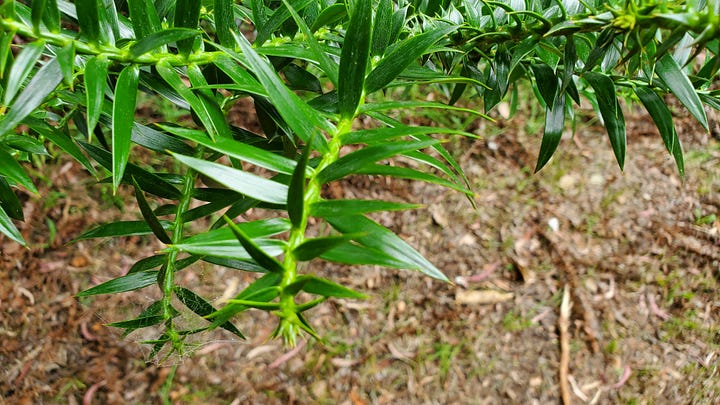


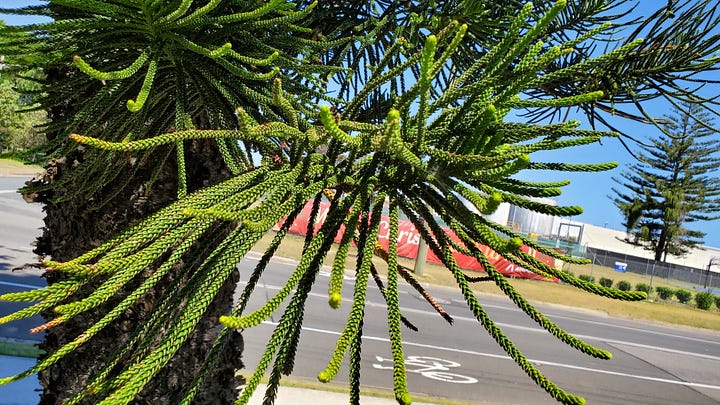
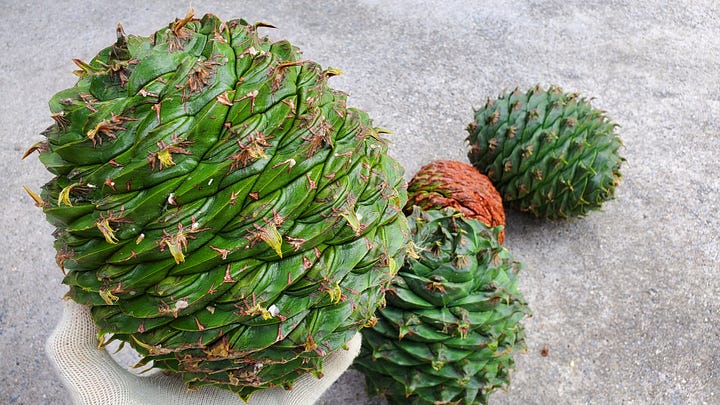
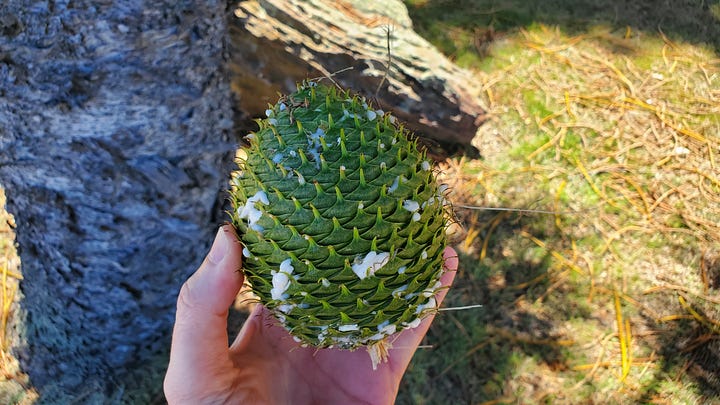
Caution!
Bunya cones pack a wallop when their 3-10kg solid, spiky mass falls from mature tree crown heights of 20-40 m. Take extreme care collecting cones during season (January-March in southern hemisphere; June-July in northern hemisphere). I personally like to observe local trees from a distance in November-December, identify and record which trees have large, ripe cones ready for harvest, and then regularly observe the ground underneath those specific trees into their season as cones drop or cockatoos dislodge them for you. Then do the mad dash with a solid, tough bag (I use an old army duffel bag which works perfectly) and collect your edible goodies.
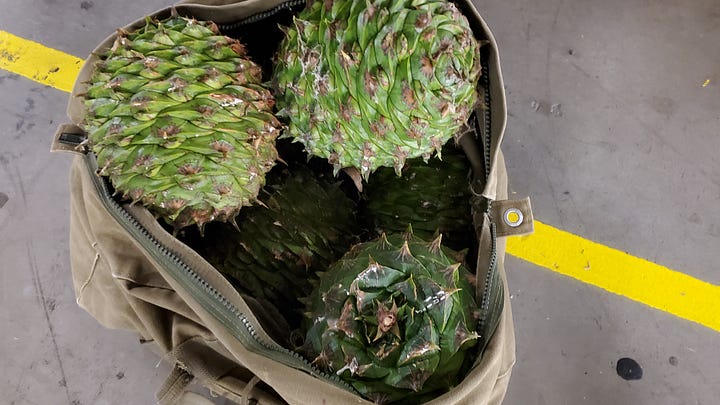

References and Further Reading
Ahamed et al. (2005), “Anti-Nociceptive and Anti-Inflammatory Activity of Araucaria bidwillii Hook.” Iranian Journal of Pharmacology & Therapeutics 4(2): 105-109. [LINK]
Ali et al. (2022), “Gastroprotective and anti-Helicobacter pylori potentials of essential oils from the oleoresins of Araucaria bidwillii and Araucaria heterophylla.” Inflammopharmacology 31: 465-483. [LINK]
Aslam et al. (2013), “Phytochemical and Ethno-Pharmacological Review of the Genus Araucaria – Review.” Tropical Journal of Pharmaceutical Research 12(4): 651-659. [LINK]
Brophy et al. (2000), “The steam volatile oil of Wollemia nobilis and its comparison with other members of the Araucariaceae (Agathis and Araucaria).” Biochemical Systematics and Ecology 28 (6): 563-578 [LINK]
Chen at al. (2011), “Labdane Diterpenoids and Shikimic Acid Derivatives from Araucaria cunninghamii.” Planta Medica 77(5): 485-488. [LINK]
Dhanasekaran et al. (1993), “Pharmacological Studies of Araucaria bidwillii Hook.” Ancient Science of Life 13(1-2): 137–142. [LINK]
El-Hawary et al. (2022), “Metabolomic profiling of three Araucaria species, and their possible potential role against COVID-19.” Journal of Biomolecular Structure and Dynamics 40(14): 6426-6438. [LINK]
Fischer et al. (2022), “Bioactive Activities of the Phenolic Extract from Sterile Bracts of Araucaria angustifolia.” Antioxidants 11(12), 2431. [LINK]
Freitas et al. (2009), “Antiviral activity-guided fractionation from Araucaria angustifolia leaves extract.” Journal of Ethnopharmacology 126(3): 512–517. [LINK]
Frezza et al. (2020), “Phytochemistry, Chemotaxonomy, and Biological Activities of the Araucariaceae Family—A Review.” Plants 9(7): 888 [LINK]
Frezza et al. (2024), “Phytochemical analysis on the female cone of Araucaria bidwillii Hook.” Natural Product Research [LINK]
Gallia et al. (2020), “Pehuén (Araucaria araucana) seed residues are a valuable source of natural antioxidants with nutraceutical, chemoprotective and metal corrosion-inhibiting properties.” Bioorganic Chemistry 104: 104175 [LINK]
Jaramillo et al. (2022), “Chemical Characterization and Biological Activity of the Essential Oil from Araucaria brasiliensis Collected in Ecuador.” Molecules 27(12): 3793. [LINK]
Haebich (2005), “Assimilating the Bunya Forests.” [LINK]
Heap, E. G. (1965), “In the Wake of the Raftsmen: A Survey of Early Settlement in the Maroochy District up to the Passing of Macalister’s Act (1868).” Queensland Heritage 1(3): 3-16. [LINK]
Kumar et al. (2020), “Phytochemical constituents, antimicrobial and antioxidant activities of Kumaun Himalayan Hoop Pine bark extract.” Natural Products Research 36(4): 1095-1099. [LINK]
Lassak & McCarthy (2011), Australian Medicinal Plants, p. 196 [A. cunninghamii].
Low (1989), Bush Tucker, p. 94; pp. 220-221 [nutritional information]
Low (1991), Wild Food, p. 95.
Maiden (1889), Useful Native Plants, pp.7-8 [seeds]; p. 223 [resin]; p.377 [wood].
Mukherjee et al. (2007), “Protective effect of biflavones from Araucaria bidwillii Hook in rat cerebral ischemia/reperfusion induced oxidative stress.” Behavioural Brain Research 178(2): 221-228 [LINK]
Nadolny et al. (2022), “Sensory properties of Australian bunya nuts.” Journal of Food Science 87(6): 2732–2743. [LINK] [[flavour profile]]
Nadolny et al. (2023), “Chemical composition of bunya nuts (Araucaria bidwillii) compared to Araucaria angustifolia and Araucaria araucana species.” Food Research International 163: 112269. [LINK] [[nutritional information]]
Neto et al. (2024), “Potential of Pinhão husk (Araucaria angustifolia) as a structural reinforcement agent in the properties of edible films of Pinhão flour and gelatin.” Journal of Applied Polymer Science 141(15): e55233. [LINK] [use of nut shell to make biofilms] [LINK]
Ogren, Thomas L (2000). Allergy-Free Gardening: The Revolutionary Guide to Healthy Landscaping. Berkeley: Ten Speed Press. [LINK]
Picone, Andrew (2013). “Bunyas, Kauris and those pesky flowering plants.” CAFNEC [LINK]
Sahu et al. (2024), “Exploring the cytotoxic potential of biflavones of Araucaria cunninghamii: Precise identification combined by LC-HRMS-metabolomics and database mining, targeted isolation, network pharmacology, in vitro cytotoxicity, and docking studies.” Chemical Biology & Drug Design 103(6): e14564. [LINK]
Silva et al. (2022), “Characterization of the chemical composition (mineral, lead and centesimal) in pine nut (Araucaria angustifolia (Bertol.) Kuntze) using exploratory data analysis.” Food Chemistry 369: 130672. [LINK]
Soliman, Sabry & Abdelwahab (2023), “Araucaria heterophylla oleogum resin essential oil is a novel aldose reductase and butyryl choline esterase enzymes inhibitor: in vitro and in silico evidence.” Scientific Reports 13: 11446 [LINK]
Talaat et al. (2018), “Verification of the anti-inflammatory activity of the polyphenolic-rich fraction of Araucaria bidwillii Hook. using phytohaemagglutinin-stimulated human peripheral blood mononuclear cells and virtual screening.” Journal of Ethnopharmacology 226:44-47. [LINK]
Zimmer et al. (2015), “Drought avoidance and vulnerability in the Australian Araucariaceae.” Tree Physiology 36(2): 218-228. [LINK]
Zortéa-Guidolin et al. (2017), “Influence of Extrusion Cooking on In Vitro Digestibility, Physical and Sensory Properties of Brazilian Pine Seeds Flour (Araucaria Angustifolia).” Journal of Food Science 82(4): 977-984. [LINK]


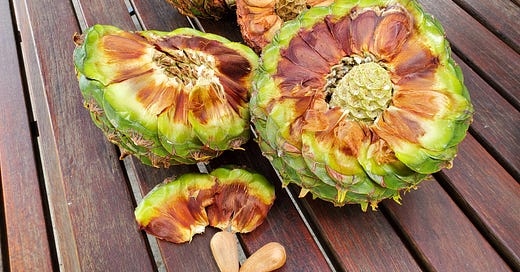




Amazing as always!
Wow, that was very thorough. I must start looking for the cones as it was mid January last year that I was processing them. We have collected some each year that we’ve been here (3). There’s one tree that we can see quite a few on. And I still have a few in my freezer to get rid of! Better make a cake. I like the cooked nuts processed for cakes better than the flour. I need to play around with flour more this year. The better flour to use was fresh dried as opposed to cooked and dried. I didn’t realise that they were so nutritious!